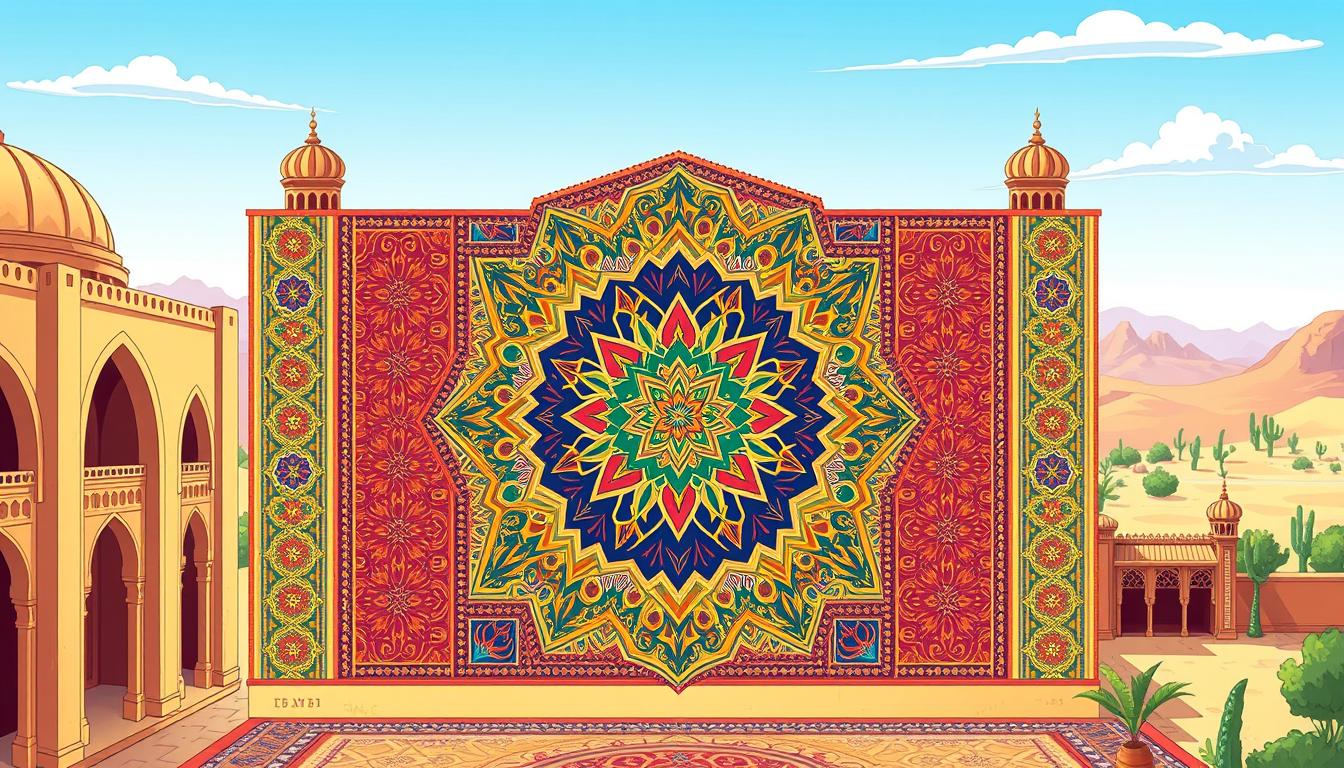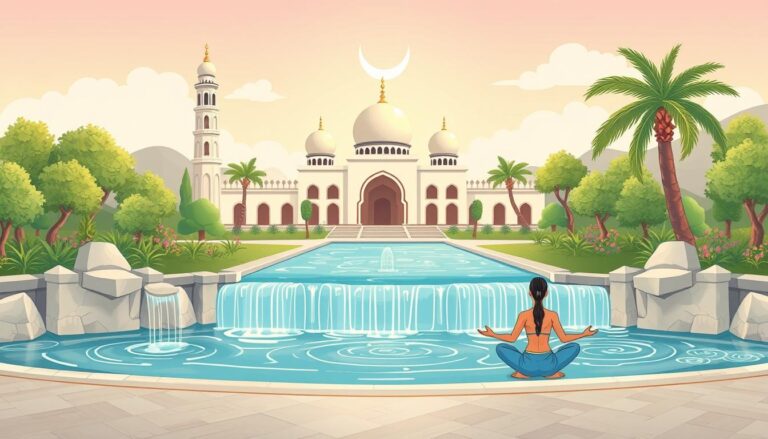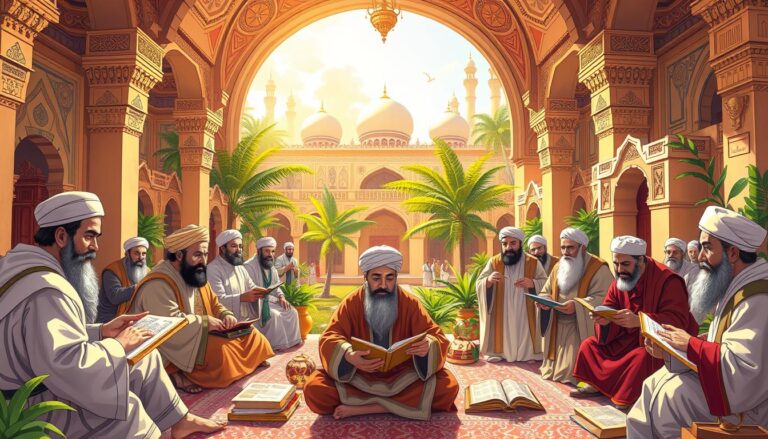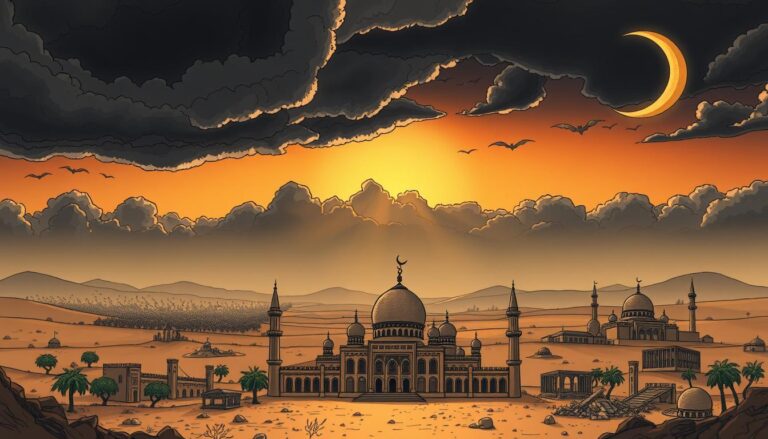Why Islamic Art Continues to Inspire Creators Worldwide
Have you ever wondered why Islamic art’s intricate patterns and mesmerizing designs still captivate us? This fascination comes from a rich history that has left a lasting impact on art worldwide.
Islamic art’s influence spans three continents and over 14 centuries. It has created a unique legacy that inspires artists today. From the early Umayyad caliphate to modern times, Islamic art has kept its unique style while changing with the world.
The beauty of Islamic art lies in its stunning decorations. These often mix calligraphy, geometric patterns, and arabesque designs. This mix creates a language that speaks to people across cultures and time, inviting us to explore its beauty.
Today, Islamic art’s influence goes beyond its origins. Its principles can be seen in Art Deco and abstract paintings. Modern artists also find inspiration in its timeless beauty. This connection between past and present keeps Islamic art alive and vibrant.
Key Takeaways
- Islamic art spans 14 centuries and three continents
- The Umayyad caliphate period was formative for Islamic art
- All-over surface decoration is a hallmark of Islamic art
- Calligraphy, geometric patterns, and arabesque are key elements
- Islamic art continues to influence modern artistic expressions
- Contemporary artists still draw inspiration from Islamic art principles
The Rich Heritage of Islamic Art
Islamic art history spans over 1400 years. It shows a rich mix of cultural influences and artistic legacy. Born in the 7th century CE, it flourished in Muslim territories, leaving a lasting impact on art worldwide.
Origins and Historical Significance
The roots of Islamic art come from various sources. It blends Roman, Early Christian, Sassanian, and Central Asian traditions. This mix created a unique look that went beyond borders. Chinese art also played a big role, influencing Islamic painting, pottery, and textiles.
Key Characteristics and Themes
Islamic art is known for its non-representational art. It features:
- Intricate plant forms and arabesques
- Stunning calligraphy
- Complex geometric patterns
Calligraphy is especially important, showing the word as a divine message. The lack of figures in religious art comes from the belief that only God can create living forms.
Influence on Global Art Movements
The influence of Islamic art goes far beyond its origins. Its unique styles and forms have inspired artists globally. This legacy continues to shape today’s art, showing Islamic art’s timeless appeal.
“Islamic art is a testament to the power of cultural synthesis, weaving together diverse influences into a tapestry of timeless beauty.”
Geometric Patterns: The Language of Islamic Design
Islamic design uses geometric patterns to speak a unique language. These designs start with a single point and grow into complex shapes. They use simple tools like a compass and straightedge.
These patterns show the unity of creation under one God. They represent the infinite nature of the divine.
Islamic geometric patterns fall into two categories: geometric and biomorphic. Geometric patterns include stars with five, six, eight, ten, or twelve points. Biomorphic patterns take inspiration from nature, creating an abstract look.
These patterns can be found in mosques, Qurans, palaces, and objects in 55 countries. Each region has its own unique style.
The math behind these patterns is fascinating. They are logical and fit perfectly on a plane. They have even inspired modern scientific discoveries.
For example, Penrose tiling, found in Islamic geometric art, has sparked interest. It has inspired new materials in science.
- Islamic patterns appear on ceramics, metalwork, textiles, and illuminations
- They serve as a bridge to the spiritual realm
- The art focuses on decoration for transformation
Islamic geometric patterns have a wide appeal. They’ve caught the eye of Western artists like M.C. Escher and scholars in math and physics. Their universal appeal comes from their ability to transform structures into conduits of lightness and pattern.
Calligraphy: The Art of Divine Words
Calligraphy art is deeply rooted in Islamic culture. It’s not just beautiful writing; it’s a way to show faith and devotion. Arabic script is considered sacred, leading to the creation of stunning works that inspire awe and reverence.
Significance of Arabic Script in Islamic Art
In Islamic tradition, calligraphy is the pinnacle of artistic expression. It’s used to record religious teachings and historical events. Writing sacred texts is seen as a form of worship itself. You’ll find calligraphy in mosques, palaces, and even everyday objects.
Evolution of Calligraphic Styles
Islamic calligraphy has a rich history. It started in the 7th century with the first written Quran. Over time, different styles emerged. Kufic, with its bold, angular letters, was popular in early Islamic art. Later, more flowing scripts like Naskh and Thuluth developed. Each style has its own beauty and purpose.
Contemporary Applications of Islamic Calligraphy
Today, artists are exploring new ways to use Islamic calligraphy. Some mix traditional techniques with modern art forms. Others use digital tools to create contemporary interpretations of classic styles. This blend of old and new keeps Islamic calligraphy vibrant and relevant in the modern world.
“Calligraphy is the art of giving form to signs in an expressive, harmonious, and skillful manner.”
Whether carved in stone, painted on canvas, or displayed on a screen, Islamic calligraphy continues to captivate people around the globe. It does so with its timeless beauty and spiritual depth.
Arabesque: Nature’s Infinite Beauty in Art
Arabesque designs show the endless beauty of nature in Islamic art. These patterns flow beautifully, inspired by stylized plants. They became a key part of Islamic art in the Eastern Mediterranean between the 10th and 15th centuries.
Floral patterns in arabesque art mean paradise and the connection of all things. Artists mix leaves, vines, and flowers into endless designs. This art shows the belief in perfect creation and paradise for the faithful.
European artists called this style “arabesque” in the 15th or 16th century. It can be found in many things, from paper to wood and ivory.
“Arabesque patterns are a testament to the sophistication and diversity of Islamic artistic expression.”
In Islamic art, arabesque designs mix with geometric shapes and calligraphy. This mix shows the unity of nature and math. It makes viewers think about the beauty and complexity of God’s creation.
- Symbolizes themes of paradise
- Reflects diversity in unity
- Allows for personal interpretation
Today, arabesque inspires artists all over the world. Its lasting charm comes from making us wonder and think deeply about nature. From buildings to fabrics, these patterns keep influencing art globally.
The Interplay of Light and Shadow in Islamic Architecture
Islamic architecture began in the 7th century AD. It skillfully combines light and shadow in its designs. This art form makes spaces both useful and spiritually uplifting.
The use of natural light in Islamic buildings is more than just lighting. It’s a key element in creating a divine atmosphere.
Innovative Use of Natural Light
Islamic structure architects use smart techniques to control sunlight. They place windows carefully and use detailed latticework to filter light. This creates a beautiful dance of light and shadow.
This dance changes throughout the day. It brings life to geometric patterns and calligraphy.
Intricate Latticework and Screens
Mashrabiya, or ornate wooden screens, are a key part of Islamic design. These screens do many things. They provide privacy, cool interiors, and create stunning shadow patterns.
The light passing through these screens adds depth and movement to spaces.
Symbolic Meaning of Light in Islamic Culture
In Islamic tradition, light is very symbolic. It stands for divine knowledge and presence. The way light is used in architecture is a spiritual expression.
Sunlight streaming through designs creates a magical atmosphere. It reminds visitors of the divine.
“Architecture is the learned game, correct and magnificent, of forms assembled in the light.”
This quote by Le Corbusier perfectly captures the essence of light in Islamic architecture. The balance of light and shadow in these structures inspires designers today. It connects old traditions with modern ideas.
Why Islamic Art Continues to Inspire Creators Worldwide
Islamic art’s timeless appeal draws creators from all over the world. Its detailed designs and deep meanings go beyond religious and cultural limits. It serves as a treasure trove of inspiration for today’s artists, designers, and architects.
The global reach of Islamic art is clear in its ability to fit into many mediums and settings. Geometric patterns, calligraphy, and arabesque designs are rich sources of inspiration. They mix well with modern art, creating unique and eye-catching pieces.
Did you know?
- Dutch artist Moritz Cornelis Escher was inspired by Islamic geometric art for his famous optical illusions.
- The Alhambra Palace in Granada is known for its stunning geometric designs.
- Islamic art has long used math to create complex patterns.
The lasting charm of Islamic art comes from its universal themes and flexibility. It can be applied to many forms of art, from buildings to digital designs. This flexibility keeps it relevant in today’s art world and inspires artists globally.
“Islamic art is a testament to the power of beauty and symmetry in design. Its influence spans centuries and continues to shape the creative landscape today.”
Looking at Islamic art’s impact on today’s creators, we see how it influences global design trends. Mixing traditional Islamic elements with modern techniques leads to innovative and striking works. These creations connect with people all over the world.
Islamic Art in the Digital Age: New Frontiers
The digital revolution has opened exciting avenues for Islamic art. Artists now blend centuries-old traditions with cutting-edge technology. This creates fresh interpretations of classic motifs. This fusion of old and new has sparked a renaissance in Islamic artistic expression.
Digital Reinterpretations of Traditional Motifs
Digital art tools allow artists to reimagine Islamic patterns and calligraphy. These modern works maintain the essence of Islamic art while pushing creative boundaries. The hashtag #ArtMubarak on social media showcases this trend, with over 4,000 Muslim artists sharing their digital creations.
Virtual Reality Experiences of Islamic Art
Virtual reality offers immersive encounters with Islamic art and architecture. Users can explore intricate mosque designs or walk through virtual galleries. This technology brings Islamic art to life, allowing people worldwide to appreciate its beauty and complexity.
Social Media’s Role in Popularizing Islamic Art
Social media platforms have become powerful tools for sharing Islamic art. Artists use these channels to reach global audiences, fostering cross-cultural appreciation. For example, one artist’s post of strong female characters in hijabs received over 2,000 likes, while another’s illustrations on Yemeni culture raised funds for humanitarian work.
The digital age has transformed how we create, experience, and share Islamic art. From virtual reality tours of ancient mosques to viral social media posts, technology is bringing this rich artistic tradition to new audiences. It is inspiring a new generation of creators.
Cross-Cultural Inspirations: Islamic Art in Global Design
Islamic art has a big impact on design worldwide. Its use of geometry, symmetry, and repetition is seen in buildings, clothes, and graphics. This has led to a mix of styles that make global design richer.
In the Middle Ages, Islamic art was a big hit in Europe. Textiles from the Islamic world were used in church clothes and fancy outfits. This influence spread to other art forms too.
In places like Norman Sicily, Muslim artists worked on mosaics, metalwork, and ivory carvings. Their work was a mix of their traditional style and local influences.
The influence of Islamic art is clear in Romanesque and Gothic styles. Hispano-Moresque pottery, made in Al-Andalus, was loved by Christian leaders in Europe. These Islamic goods were better than anything made in Europe until the late Middle Ages.
Today, designers still find inspiration in Islamic art. They make new, innovative pieces that connect different cultures. This shows how Islamic design keeps influencing the world of design.
Preserving and Promoting Islamic Art in the Modern World
Islamic art is a treasure from centuries past. Today, it’s more crucial than ever to keep it alive. Museums, educational programs, and digital tools are key in this effort.
Museums and Exhibitions
The Metropolitan Museum of Art is a prime example. It brings Islamic art to people all over the world. Visitors get to see the beauty and detail of Islamic art up close. Exhibitions also showcase rare pieces, sparking interest in preserving art.
Educational Initiatives
Workshops and classes on Islamic art are becoming more popular. These programs help people understand Islamic art’s intricate patterns and calligraphy. By learning these skills, participants help keep this art tradition alive.
Digital Archives
The digital world has opened new ways to preserve Islamic art. Online resources make ancient masterpieces available to all. Digital archives let researchers and art lovers study Islamic art from anywhere, building a global community.
- Virtual tours of famous Islamic architectural sites
- High-resolution images of intricate manuscript illustrations
- Interactive lessons on geometric pattern creation
Together, these efforts keep Islamic art’s cultural heritage alive. It inspires and educates people everywhere. Preserving this art ensures future generations can enjoy its beauty and history.
Conclusion
Islamic art’s legacy is still captivating artists around the world. It combines spirituality, mathematics, and beauty in a unique way. This mix inspires many today, from artists to designers.
Starting in the 7th century, Islamic art has grown and changed. It has been shaped by Greek, Persian, and Indian traditions. This evolution makes it a rich source of inspiration.
Islamic art is known for its use of calligraphy, architecture, ceramics, and literature. These mediums help share knowledge and preserve important texts. They also promote balance, harmony, and proportion, encouraging respect and understanding between cultures.
In today’s digital world, Islamic art is finding new ways to connect with people. Artists are using digital tools and virtual reality to share their work. This keeps Islamic art relevant and alive, linking the past with the present.
Source Links
- The Nature of Islamic Art | Essay | The Metropolitan Museum of Art | Heilbrunn Timeline of Art History
- Finding Inspiration: An Abstract Artist’s Journey into Islamic Art – ezeeart
- Islamic art
- Exploring the Intricate Techniques of Islamic Art
- How to learn Islamic patterns? — Art of Islamic Illumination
- Islamic geometric patterns
- Islamic Calligraphy: The Beauty of the Written Word in Art
- Qur’ānic Calligraphy: The Flourishing Art of Divine Words
- Exploring the Intricate Techniques of Islamic Art
- Arabesque is a distinct style in Islamic art
- Exploring the Beauty and Symbolism of Islamic Geometric Patterns
- Introduction to Islamic Art – Muslim Heritage
- Byzantine and Islamic Architecture | History of Architecture Class Notes
- Islamic Decorative Arts | Islamic Art and Architecture Class Notes
- Everything to know about Islamic Architecture and Its Global Influence
- The Stunning Beauty of Islamic Geometry
- A Global Guide to Islamic Art – TeachMideast
- Building an Islamic Art Museum
- #ArtMubarak: Hashtag celebrates art by Muslims around the world
- Exploring the Intricate Techniques of Islamic Art
- Islamic influences on Western art
- Islamic art and architecture | Islamic World Class Notes
- The positive impact of Islamic art on society — Edugist
- The Silent Theology of Islamic Art
- Diversity in Unity: Islamic Art Across Global Horizons
- The Role of Art in Knowledge Transmission in the Muslim World







